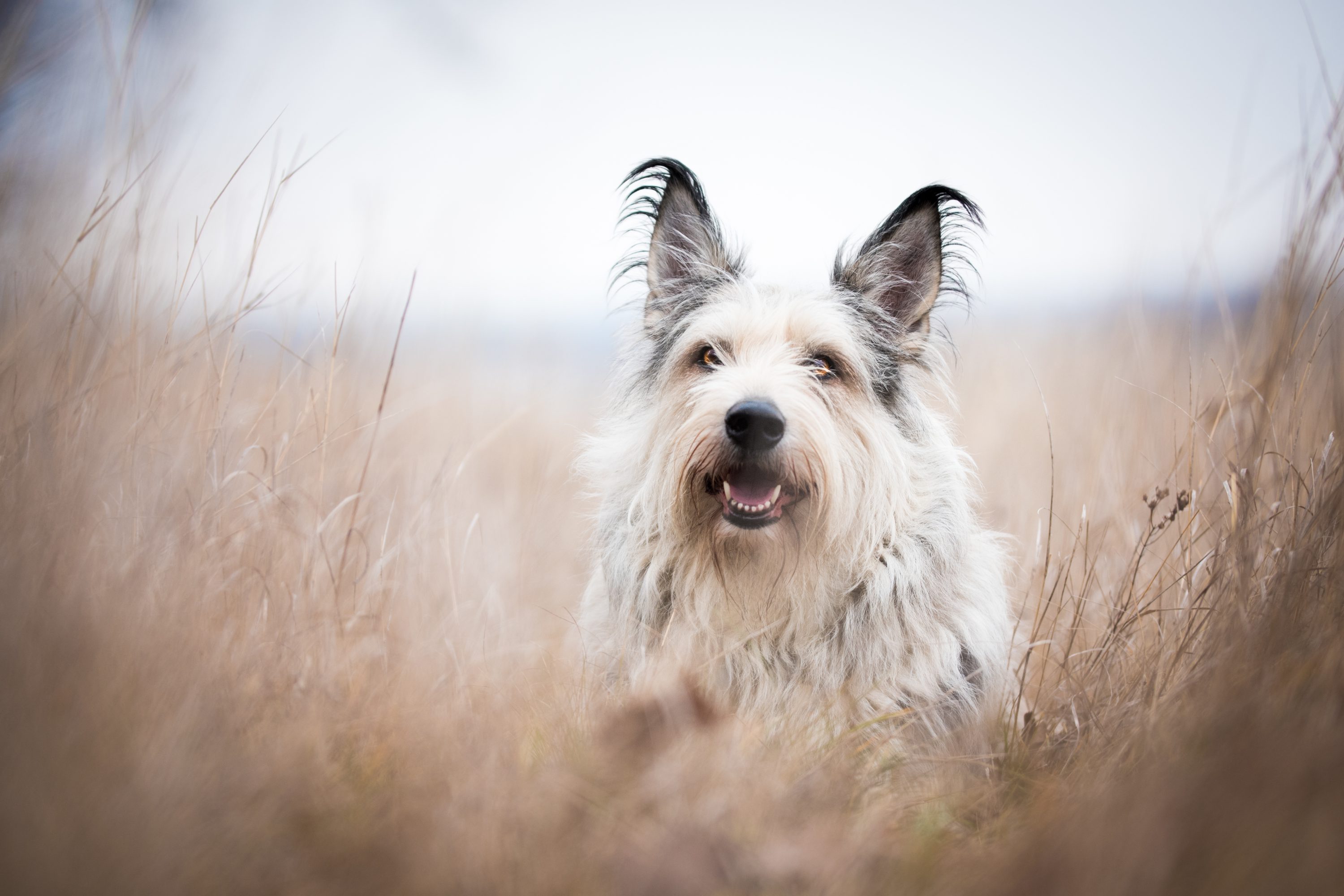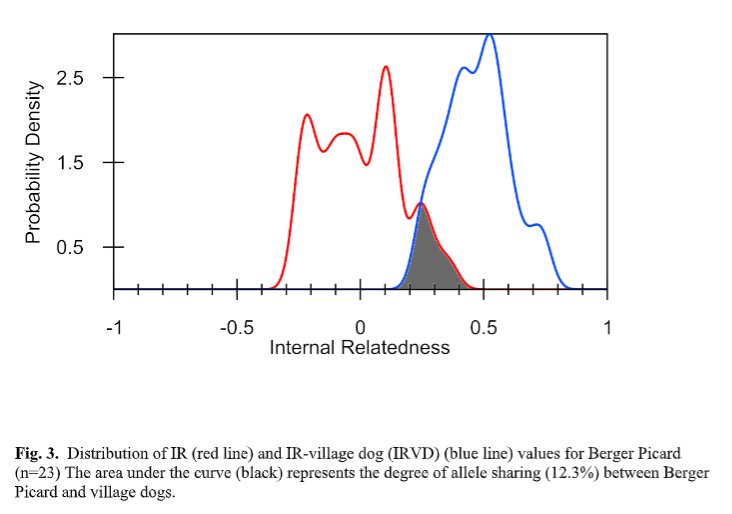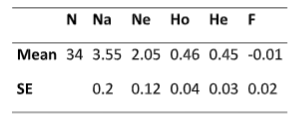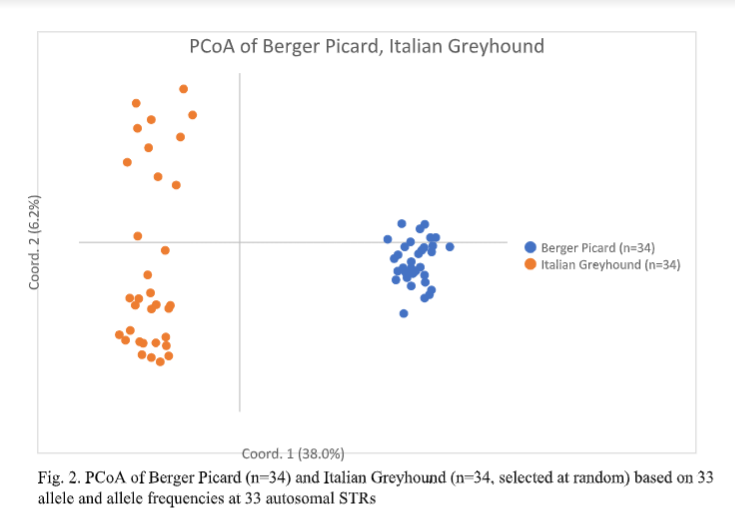
Preliminary breed report: Berger Picard!
UC Davis has been releasing preliminary breed reports once they feel that they have enough dogs to take a very initial look at a breed. Depending on the sample and how well those initial dogs were selected, it is possible they will represent a good snapshot of the breed. Of course, results will change some as more dogs are added.
So, what did UC Davis’ professor emeritus Dr. Niels Pedersen BS, DVM, PhD find in regard to the Berger Picard in this preliminary analysis? The following article summarizes the full breed report written by Dr. Pedersen. You can find the full report here.
This report is based on testing of 34 carefully selected Berger Picards; chosen to represent unrelated bloodlines within the breed. While 34 individuals is not enough for a final analysis, it should give a good initial approximation of the status of the breed. We need more Berger Picards to be contributed, so please consider adding yours!
How inbred is the typical Berger Picard?
One part of the UC Davis canine diversity test is called Internal Relatedness or IR. This is an often used conservation genetics measurement that estimates how inbred a dog is. This measurement will range from 0 to 1 when a dog is more inbred, and from 0 to -1 when the dog is outbred. An outbred puppy would inherit genetics from its sire that were very different from those it inherited from its dam. An inbred puppy would inherit many of the exact same genetics from both its dam and sire. Being outbred reduces the likelihood of known and unidentified recessive component diseases expressing in individuals.
So, how inbred or outbred are the individuals in the Berger Picard breed?
From the preliminary report:
The most outbred dog in the population had an IR score of -0.246, while the most inbred dog in the group had an IR score of 0.360, while the mean (average) IR score for the group was 0.000. Therefore, the population appeared to contain small and equal proportions of dogs that had parents that were as unrelated (most outbred) or related as possible (most inbred) given the genetic makeup of the population.
Dr. Niels Pedersen 2019
To translate – the range of inbreeding in the breed is broad and there are roughly equal numbers of inbred and outbred dogs in the bred. Because we can’t necessarily detect this without DNA testing and analysis, this breed can benefit from predictive software aiding in selection of breeding mates, to insure that future breedings are not too close, risking health as a result.
How much biodiversity exists in the Berger Picard today?
Dr. Pedersen’s reports look at the data from the VGL canine diversity test in many different ways, in order to assess the total amount of biodiversity within a breed. Many of these measures together give us an overall picture of the state of the breed and as a result we can make informed decisions on breed management.
The best explanation I’ve yet read is from BetterBred Founder Natalie, and as a result we will share it again here!
Most breeders think of DNA as coming in two options- a good gene, or a mutant gene – like it is in many DNA tests. In fact, there are many genes or (in this case) markers that come in a great many variations – like a t-shirt that is available in different colors. The more variants there are, the more information we have about population genetics. In more inbred breeds, there are fewer variants for each marker. So an inbred breed might have only a few colors available in t-shirts, whereas a diverse breed will have many colors of t-shirts. Apart from the relatively small number of genes that make up specific, visible breed traits, the rest of the gene pool is generally healthier when there’s lots of variation.
Unfortunately when breeders select too strictly for too long for very specific traits, there can be an unintended loss of variation in the parts of the DNA that thrive with more variation. A good way to assess whether that good variation has been impacted is using the markers found in the VGL canine diversity test. Because they are considered neutral – or not associated with any specific known trait – they are great for assessing genetic diversity. In breeds with ample diversity, there will be lots of variations for each marker (lots of colors in the t-shirt drawer.)
But what if you have a breed without much variation? Well, this happens, and can happen quite often. In this case the best thing breeders can do is try to make sure the variants that are in the breed are well distributed – so there are plenty of all of them in the breed. Imagine a t-shirt drawer with lots and lots of red t-shirts and only one blue one and one green one. If you lose one of the red ones, it doesn’t change much about the t-shirt drawer – there are lots of other red ones. But if you lose either the blue or green one, the variation is seriously diminished. If, on the other hand a third of the shirts are red, and a third are green and a third are blue, then it’s a lot harder to lose the existing variation in the drawer, even if you lose one once in a while and even though there are only 3 colors.
The Berger Picard’s biodiversity

Another use of an individual’s inbreeding value: we can look at the inbreeding level of all individuals in the breed in aggregate – meaning the whole breed altogether. When a breed has had very few founders, or has had genetic bottlenecks in its history, whether from breeding practices or world events, it can mean, years later, that there is very little biodiversity left within the breed. By adjusting inbreeding values in comparison to the data from village dogs (often considered the “ideal” comparison,) researchers can estimate the remaining biodiversity of a modern breed compared to the original diversity that once existed in dogs prior to breed formation.
So when this investigation was done, what did Dr. Pedersen see?
Almost all of the 34 Berger Picard have IRVD values of 0.247 and greater (Table 4; Fig. 3) and if they were found today among village dogs, they would all be judged offspring of at least full sibling parents. Most of them would be even more related, with parents that are more closely related to each other than siblings from a large and genetically diverse random breeding dog population.
The darkened area in Figure 4 representing the overlap of IR and IRVD curves is an estimate of the amount (12.3%) of genetic diversity in present-day randomly breeding village dogs that still exists in contemporary Berger Picard.
Dr. Niels Pedersen 2019
This assessment indicates there is very little biodiversity in this breed, but let’s look at the data another way.

A secondary way to estimate the loss of biodiversity within a breed is to look at the average number of alleles found at each tested locus, and compare those to all the canine breeds thus far tested at UC Davis VGL. When looking at the number of alleles found, we might consider two things: the average number of alleles found in total (Na = average alleles), and the average number of alleles that are effectively contributing to the population (Ne = effective alleles). Going back to the t-shirt analogy above, say we have 10 t-shirts, and 8 of them are red and one is green and one is yellow. The total number of shirt colors is 3, however the majority color is red, therefore our “effective” t-shirt color would be only 1.
So, by looking at these numbers, what do we find out about this population?
The alleles identified in this group of 34 dogs (Na) represented 3.55/15.4=23% of alleles known to exist at each of these loci in all canids tested at the VGL. This is the lowest amount of retained canid genetic diversity observed in any breed to date. It is even lower than the retained canid-wide genetic diversity of the Swedish Vallhund (31.9%), Irish Red and White Setter (34.8%) and Flat Coated Retriever (38.6%); and less than one-half of the retained canid genetic diversity of the most genetically diverse breeds such as the Golden Retriever (54.5%), Toy Poodle (55.6%) and Standard Poodle (58%).
The 34 Berger Picards had an average of 3.55 alleles/loci (Na), while the Ne in this group of dogs averaged 2.05 alleles per locus. This means that 2.05/3.55=58% of the alleles accounted for most of the existing heterogeneity (heterogeneity=genotypic variation=phenotypic variation). This is typical for most pure breeds of dogs.
Dr. Niels Pedersen 2019
The estimate of remaining biodiversity left after breed formation using this method is only 23%. Additionally, Dr. Pedersen discovered that there is more diversity within the breed than is being effectively used. What do you do in the case of having diversity not contributing to the breed effectively? You identify individuals who may have unusual genetics for the population, and work to preserve those genetics and redistribute them in the population at large.
It is clear from both assessments that the Berger Picard breed only has retained a small amount of the genetic variation compared to all other breeds analyzed thus far. Given that almost all the dogs sampled appear to not be closely related, this lack of biodiversity is likely true for the breed as a whole. In fact, according to the report, this breed has the lowest biodiversity of any breed studied at VGL to date. From Dr. Pedersen’s report “Regardless of reference populations, it is apparent that Berger Picards have retained only a small amount of available canid genetic diversity.“
These findings may change as more dogs are tested, and it is imperative for conscientious breeders to find and preserve any as yet unseen diversity. How can they do that? First by testing as many dogs as possible, and keeping a keen eye out for healthy unusual or long isolated lines where perhaps there may be more variation.
Breed relationships

Another use of the data from the VGL canine diversity test is to see how the individuals within the population fit in relation to one another. What do we see when we look at this analysis, called the PCoA graph?
The 34 Berger Picard formed a single population (i.e., breed) in PCoA (Fig. 1). Individual dogs in the group were reasonably dispersed across all four quadrants of the graph, with the exception of two pair of dogs that graphed together and were therefore more closely related than the others
Dr. Niels Pedersen 2019
(Fig. 1). A number of other individuals appeared as outliers from the main population on the periphery of the graph. It can be assumed, therefore, that this group of 34 dogs, with the exception of these two pairs, were as unrelated as possible given the low amount of existing genetic diversity.

It appears the sample that has been collected thus far has included a broad sample of dogs from the Berger Picard population, most of whom are as unrelated as possible.
Additionally, the breed’s PCoA can be compared to other breeds. Dr. Pedersen chose to compare the Berger Picard with the Italian Greyhound. In this comparison, it becomes strikingly obvious how closely related Berger Picards are to one another and how little genetic variation there is within the breed as compared to another more diverse breed. Ironically, Italian Greyhounds are considered a fairly historically inbred breed, but they are clearly more diverse that the Berger Picard.
The immune system
The UC Davis VGL canine diversity test can identify more regions of the DLA than any other test available today. The DLA, called Dog Leukocyte Antigen, is the region of the DNA that codes for the immune system in the dog. There are three regions, Class I, Class II and Class III. This test identifies both Class I and II haplotypes (a haplotype is a tightly linked group of genes within an organism that is inherited as a group from a single parent). To learn more about the DLA, read here.
The 34 Berger Picards possessed only 2 DLA class I and 2 DLA class II haplotypes (Table 5).
Dr. Niels Pedersen 2019
One class I (1227) haplotype was unique to the breed, and the three remaining haplotypes were shared with a number of other breeds (Table 6). One class I (1227) and one class II (2067) haplotypes occurred in 96% of the dogs tested. The remaining two haplotypes occurred at an incidence of 4%.
The number of DLA class I and II haplotypes found in these 34 Berger Picard was the lowest found in a dog breed studied to date. It was even lower than breeds with limited genetic diversity such as the Swedish Vallhund (6, 4), Shiloh shepherd (7, 6), Giant Schnauzer (14, 15), Samoyed (13, 12) and Shiba Inu (16, 15). These latter breeds were, in turn, much lower than Golden Retriever (26, 23) and Miniature Poodle (33, 23). If these 34 dogs are representative of the breed as a whole, it would suggest that a single founder or closely related bloodline played a dominant role in the modern breed.
As stated by Dr. Pedersen in his conclusion below, the lack of biodiversity in the DLA is worrisome. When more dogs are added to the study, there is possibility that more DLA haplotypes will be found.
But what about these DLA haplotypes in other breeds? From Dr. Pedersen’s report: “The 1227 haplotype is unique to any breed heretofore tested by the VGL and reflects a unique founder line (Table 6). In comparison, the 1052 haplotype is found in a number of breeds but is most common in the Shiloh Shepherd and Irish Wolfhound. The 2017 and 2067 DLA class II haplotypes are found in several breeds. The 2017 haplotype is particularly common in the Polish Lowland Sheepdog, English Bulldog, Shiloh Shepherd, and Magyar Agar, while the 2067 haplotype is common in the Shiba Inu.”
Conclusions
The following conclusions from Dr. Pedersen sum up the findings from the 34 tested Berger Picards.
The most striking finding was the almost total lost of genetic diversity in the DLA regions of the genome. This region is in relatively high linkage, and the two extended haplotypes tend to be inherited by descent, with limited recombination, from each parent. The most likely cause of this pattern of lost DLA diversity is found in the breed history. Registration records showed that Radjah de la Bohème was bred to Wax de la Bohème in early 1950 to produce a fawn male (Yucca des Hauts-Chesnaux) and a brindle female (Yasmina des Hauts-Chesnaux). These two dogs reportedly became important founders of the restored Berger Picard breed [1]. A recent study indicated that the Berger Picard is also closely related to several older Italian herding breeds [6]. Therefore, it would appear that modern Berger Picards represent a remnant of a line of dogs that existed prior to the restoration and shared a unique DLA type that resulted from earlier genetic bottlenecks, or 2) result in modern time from a very small number of founders that were extensively backcrossed to a specific subpopulation of these founders.
….
The extreme lack of genetic diversity in the DLA class I and II region of these 34 Berger Picard is troublesome, but it is uncertain what it means, if anything, for the future of the breed. Certain DLA class I and II haplotypes have been associated with specific autoimmune diseases in certain breeds [8], but autoimmune disorders are not widely seen as a problem in Berger Picard. Therefore, the strongly shared DLA region of Berger Picard does not appear to have a strong negative effect on self/non-self recognition. Nevertheless, it is important that breeders maintain as much diversity and heterozygosity in the DLA region as possible.
Dr. Niels Pedersen 2019
Breeds that lack genetic diversity must be managed much more closely to avoid further loss of genetic diversity and have less leeway in dealing with simple recessive or complex polygenic disorders that might arise[10, 11]. Disease mutations are usually autosomal recessive in nature and frequently linkage with a region of the genome that is suddenly becomes subject to strong positive selection for a phenotype that is deemed desirable in the show ring[9-11]. Elimination of such deleterious mutations may result in loss of genetic diversity, especially when diversity is already limited[9-11].
In a breed with so little genetic diversity at the breedwide level, it will be of great importance to conserve the existing biodiversity so further depletion does not occur due to genetic drift. Breeders can do this by testing their dogs and placing a priority on healthy dogs with less well represented genetics in comparison to the rest of the population, provided they are good representatives of the breed. Using our tools designed to identify these individuals, Average Genetic Relatedness (AGR) and Outlier Index (OI) breeders can allow breeders to select these dogs, as well as to simulate what to expect in potential litters.
Hopefully with further analysis and more dogs submitted to the study, more biodiversity will be found within the breed and successful management and conservation of that existing diversity can be enhanced.
 Previous Post
Previous Post Next Post
Next Post


